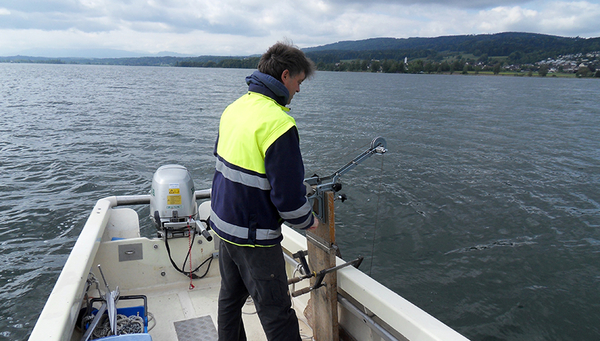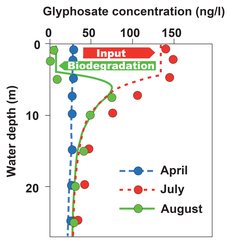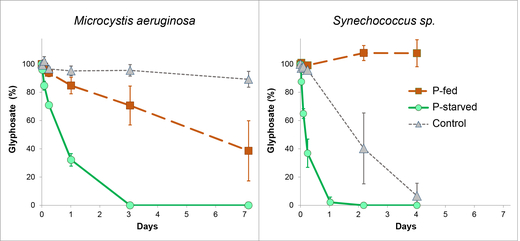Archive detail
Glyphosate eliminated by cyanobacteria
July 12, 2018 |
Glyphosate is frequently in the headlines: expert committees disagree as to whether the herbicide is carcinogenic to humans, authorities debate whether its use should be approved. In 2017, the substance was reauthorized by the EU for another five years. A Federal Council report issued in May 2018 concluded that glyphosate residues in food pose no risk of cancer. But what happens if the herbicide enters surface waters? Its toxicity to aquatic organisms is rated as low (cf. Box), but its behaviour in waterbodies has been little studied to date. Scientists from Agroscope and Eawag who investigated the occurrence and fate of glyphosate in Lake Greifen found that, under certain conditions, the substance is rapidly degraded. Sebastian Huntscha (Stötzer), who led the project as a postdoctoral researcher at Agroscope, points out: “Such rapid degradation processes are rather unusual for herbicides in surface waters.”
Losses of glyphosate
Previous studies had already shown that glyphosate concentrations decline sharply in natural waters during the summer. The researchers wished to investigate the seasonal dynamics and the underlying processes in more detail. For this purpose, from early spring to late autumn, they measured the concentrations of glyphosate and its main metabolite AMPA in monthly samples collected at several depths in Lake Greifen, and in weekly samples from two tributaries and the outflow. In addition, analyses were carried out on effluent samples from the Uster wastewater treatment plant (WWTP). This data was used to establish a mass balance: during the study period, total glyphosate inputs to the lake amounted to around 22 kg, but only 5.4 kg was exported via the Glatt river. A large proportion of the herbicide was thus “lost” within the lake. The concentration profiles showed a similar picture: concentrations of glyphosate and AMPA in the upper layer of the lake (epilimnion) rose sharply in July, and then suddenly declined almost to the point of disappearing in August – even though glyphosate and AMPA continued to enter the lake via the tributaries.
Possible elimination processes
The researchers compared these results with simulations of glyphosate and AMPA concentrations at various lake depths obtained using a mathematical model. The modelling took account of inputs from tributaries and WWTPs, export via the Glatt, and mixing processes. The modelled concentrations corresponded to the vertical concentration profiles measured for glyphosate from March to July. “But in August,” says Huntscha, “the values measured were much lower than those estimated by the model, so it was clear that elimination processes must occur within the lake.”
In principle, glyphosate and AMPA can be removed from lake water via sorption to particles and subsequent sedimentation, or by photolysis. Estimates based on the findings of earlier studies showed that, while sedimentation processes may contribute to the overall elimination of glyphosate and AMPA, they cannot explain the rapid decline in concentrations during the summer. Degradation of the substances via photolysis was also excluded experimentally. According to Huntscha, “We therefore assumed that – in the summer – glyphosate and AMPA are mainly degraded biologically.”
Phosphorus source for cyanobacteria
The low glyphosate concentrations coincided with high water temperatures and phytoplankton densities, and low phosphate concentrations. As Michael Stravs of Eawag explains, “We know that cyanobacteria – sometimes also called blue-green algae – are able to utilize phosphorus compounds such as glyphosate as an alternative source of phosphorus.” Measurements of chlorophyll a (an indicator of algal biomass) showed that, in months with rapid glyphosate elimination, phytoplankton densities were also high. In addition, using genetic analysis, the scientists identified the dominant taxonomic groups of phytoplankton: proteobacteria and cyanobacteria were the most abundant phyla, while Synechococcus showed the highest abundance at the genus level. Using this and another cyanobacterial species from Lake Greifen (Microcystis aeruginosa), Stravs then performed degradation experiments: “As certain cyanobacteria are able to store phosphate, we first starved the bacteria and incubated them in a phosphate-free medium.” Controls were grown under optimum nutrient conditions, and both groups then received glyphosate. Stravs says: “The herbicide was rapidly degraded by the phosphate-starved bacteria, which had no other phosphorus source available.” Limited degradation was observed in the other group, which preferred more readily available phosphorus sources to glyphosate. Stravs concludes: “There was strong evidence that cyanobacteria are responsible for the rapid degradation of glyphosate in Lake Greifen.” However, as the scientists emphasize, this does not provide carte blanche for the use of glyphosate. “Biodegradation only occurred when phosphate concentrations were extremely low,” says Stravs.
Ecotoxicity and water quality requirements
Glyphosate is toxic to aquatic organisms only at relatively high concentrations or in combination with a wetting agent (surfactant), whose use as a glyphosate co-formulant is banned in Switzerland and the EU. According to scientific experts, the greatest risks for animals and plants arise from the changes in food resources and habitat conditions which occur when weeds are completely eliminated by glyphosate (cf. Ecotox Centre info sheet on glyphosate).
Under the revised Waters Protection Ordinance, recently released for consultation, the limit specified for glyphosate in surface waters is therefore to be raised from 0.1 µg/L to 360 µg/L – i.e. a 3600-fold increase. This proposal has been sharply criticized, especially by environmental organizations.
Publication
Glyphosate concentrations measured at various depths in Lake Greifen in spring and summer 2013. The herbicide is used in agriculture from the start of the vegetation period and enters the lake via surface runoff during rain events. Biological degradation processes are responsible for the sharp decline in concentrations between July and August.
(Source: Agroscope)



